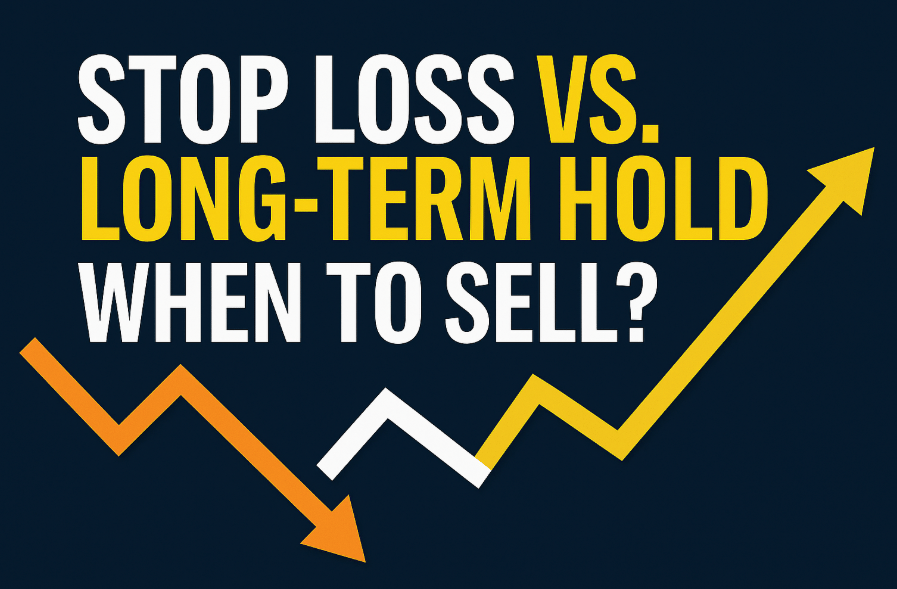- Live Life Grow Wealth
- Posts
- 🛡 Series 4 Day 4: Stop Loss vs. Long-Term Hold — When to Sell?
🛡 Series 4 Day 4: Stop Loss vs. Long-Term Hold — When to Sell?

Today’s Headline
🛡 Series 4: Risk Management & Protecting Your Wealth
Day 4: Stop Loss vs. Long-Term Hold — When to Sell?
When it comes to investing, buying is the easy part. Selling — that’s where emotions, confusion, and second-guessing come in. I’ve seen people hold onto losing stocks for too long, hoping they’ll “bounce back.” I’ve also seen others sell too early, only to watch the price skyrocket later.
So, how do we know when to sell? Should we use a stop loss strategy to cut losses quickly, or should we hold for the long term and ride out the ups and downs? Today, I want to break this down in a simple, human way — so you’ll know how to protect your money and grow it wisely.
“Every Trend Has a Trigger — This Newsletter Shows You Where the Money Will Move”
Turn AI Into Your Income Stream
The AI economy is booming, and smart entrepreneurs are already profiting. Subscribe to Mindstream and get instant access to 200+ proven strategies to monetize AI tools like ChatGPT, Midjourney, and more. From content creation to automation services, discover actionable ways to build your AI-powered income. No coding required, just practical strategies that work.
💡 First, Let’s Understand What “Stop Loss” Means
A stop loss is a strategy where you decide in advance the maximum amount of loss you’re willing to take on an investment. It’s like an emergency exit. You set a price — and if your stock drops below that, you sell automatically.
For example:
Let’s say you buy a stock at $100 and decide to set a 10% stop loss. That means if the stock price falls to $90, you’ll sell. The idea is to limit your loss and protect your capital before things get worse.
A stop loss is like wearing a seatbelt. You hope you never need it — but when a crash happens, it can save you from serious damage.
⏳ The Other Side: Long-Term Holding
Now, the opposite approach is long-term holding — buying strong companies and holding them for years, no matter how the market moves.
This strategy is built on the belief that, over time, the market goes up. History supports it — the stock market has always recovered from crashes, wars, recessions, and crises.
Think about investors like Warren Buffett. He doesn’t panic when prices drop. He focuses on the business, not the daily price. That’s what long-term investors do — they ride through short-term storms because they trust in long-term growth.
🧩 So, Which One Is Better?
The truth is — both have their place.
It depends on:
Your personality
Your goals
Your risk tolerance
The type of investment you’re holding
Some investors can sleep peacefully through market dips. Others panic at the first sign of red.
Neither is right or wrong — what matters is choosing a strategy that matches you.
⚖️ The Key Difference Between the Two
Let’s simplify it:
Strategy | Goal | Best For | Mindset Needed |
|---|---|---|---|
Stop Loss | Limit losses and protect capital | Traders or short-term investors | Quick decision-making, discipline |
Long-Term Hold | Ride out volatility for future growth | Long-term investors | Patience, emotional control |
Both strategies work — just not for the same kind of investor.
If you’re trading for short-term gains, stop loss is essential. But if you’re building wealth over decades, long-term holding usually wins.
🧠 Why Stop Losses Are Useful (When Used Wisely)
Let me be honest — emotions are the biggest enemy of investors. When a stock drops, fear takes over. We tell ourselves, “Maybe it’ll recover.” But sometimes, it doesn’t.
That’s where a stop loss helps. It forces you to stick to your plan, not your emotions.
Here’s why I like having a stop loss — especially for short-term positions:
Protects Your Capital – Keeps small losses from turning into big ones.
Promotes Discipline – Helps you follow your strategy instead of panicking.
Saves Emotional Energy – You don’t have to constantly watch prices.
Improves Consistency – Keeps your risk-per-trade within limits.
Remember, investing isn’t about avoiding losses completely — it’s about managing them.
🪫 The Drawback of Stop Losses
While stop losses protect you, they can also backfire if used too tightly.
Sometimes, a stock might dip temporarily before bouncing back stronger. If your stop loss triggers too early, you might sell right before the rebound.
Here’s what I mean:
Imagine buying a strong company at $100. It dips to $90, triggering your stop loss. You sell.
But a few weeks later, the stock climbs to $120. You’re left frustrated — and that’s how many investors get stuck chasing losses.
So the key is balance. You want a stop loss that protects you without cutting off your long-term potential.
📈 Why Long-Term Holding Works (For the Right Investor)
The long-term hold strategy is simple: buy quality businesses and let time do the heavy lifting.
Here’s why this approach has worked for so many successful investors:
Compounding Magic – The longer you stay invested, the more your returns compound.
Reduced Timing Risk – You don’t need to predict when to buy or sell.
Fewer Emotional Mistakes – You focus on the company’s growth, not daily prices.
Tax Efficiency – Holding long-term often means fewer capital gains taxes (in some countries).
But there’s one condition — you must invest in good businesses. Holding onto bad companies for too long isn’t patience, it’s denial.
"Boost your investment strategy by unlocking the power of CTV advertising with Roku Ads Manager—learn how to maximize returns this holiday season. Click here to explore!"
It’s go-time for holiday campaigns
Roku Ads Manager makes it easy to extend your Q4 campaign to performance CTV.
You can:
Easily launch self-serve CTV ads
Repurpose your social content for TV
Drive purchases directly on-screen with shoppable ads
A/B test to discover your most effective offers
The holidays only come once a year. Get started now with a $500 ad credit when you spend your first $500 today with code: ROKUADS500. Terms apply.
⚠️ When Long-Term Holding Fails
I’ve seen people use “long-term” as an excuse for not facing reality. They hold onto poor-performing stocks for years, hoping they’ll recover.
Here’s the truth: not every company bounces back.
Industries change. Management fails. New competitors emerge.
That’s why long-term investors must still review their holdings periodically.
If the company’s fundamentals are broken, it’s better to cut your losses than to keep sinking.
Remember — long-term investing doesn’t mean never selling. It means holding good companies long enough for them to grow.
🧮 Finding the Right Balance — My Approach
Personally, I use a blended strategy. I like to hold strong, fundamentally sound companies for the long term. But for riskier or speculative positions, I use stop losses to protect myself.
Here’s how I think about it:
Core Portfolio (Long-Term Holdings)
Companies with strong financials, good management, and consistent earnings.
I plan to hold these for years.
I don’t panic if they dip temporarily — I use downturns to buy more.
Satellite Portfolio (Tactical Positions)
Smaller, more aggressive bets.
I use stop losses here to limit downside risk.
This “core and satellite” method gives me both safety and growth potential. It also keeps my emotions in check because I know what each position is meant for.
🧱 Setting the Right Stop Loss
If you decide to use stop losses, here are a few tips:
Don’t Set It Too Tight – A 5% stop loss might trigger too often. For most stocks, 10–20% is more realistic.
Use Technical Levels – Look at previous support levels or moving averages instead of random numbers.
Adjust Over Time – As your stock price rises, move your stop loss upward to protect profits.
Avoid Emotional Changes – Don’t keep lowering your stop loss just to “give it more room.” That defeats the purpose.
Think of stop losses as guardrails — they keep you from driving off a cliff, not from taking small bumps on the road.
⏰ Knowing When to Sell Long-Term Holdings
Even long-term investors need exit rules.
Here’s when I usually consider selling:
Fundamentals Deteriorate – The company’s earnings, management, or business model weaken.
Valuation Becomes Unrealistic – When the stock price is far above its fair value.
Better Opportunities Appear – Another investment with stronger potential emerges.
Personal Goals Change – You need the funds for a major life goal, like buying a home or retiring.
Selling isn’t failure — it’s part of smart portfolio management.
🧘♂️ Emotional Control: The Common Thread
Whether you use stop losses or hold long-term, the hardest part isn’t the math — it’s the emotions.
Fear makes us sell too soon. Greed makes us hold too long.
That’s why I always remind myself:
“The goal isn’t to be perfect — it’s to stay disciplined.”
Investing success doesn’t come from timing the market. It comes from time in the market — with a plan that keeps your emotions under control.
📊 A Simple Framework You Can Follow
Here’s a simple 4-step framework you can apply right now:
Define Your Investment Type
Is this a long-term holding or a short-term trade?
Set Your Exit Plan Before Buying
For short-term trades, use a stop loss.
For long-term investments, define when you’ll review it (e.g., quarterly).
Track the Fundamentals
Stay updated on earnings reports, debt levels, and company news.
Review Regularly
Every 6–12 months, check if your holdings still fit your goals.
Having a plan makes selling a decision, not an emotion.
💬 My Personal Takeaway
I’ve learned that the best investors aren’t the ones who always make the right moves — they’re the ones who make consistent, rational moves.
Selling is just as important as buying. And the best time to decide when to sell is before you buy.
A stop loss protects you from yourself when emotions run wild.
A long-term hold rewards you when patience runs deep.
The key is to know which approach fits your style — and stick with it.
Final Takeaways
Selling is not about giving up — it’s about moving forward.
Whether you’re cutting losses or locking in profits, every sale teaches you something about your investing personality.
There’s no single “right” answer between stop loss and long-term holding. The right choice is the one that helps you stay consistent, calm, and committed to your financial goals.
📣 Call to Action
Today, take a look at your portfolio.
Ask yourself:
Do I have a clear plan for when to sell?
Am I holding anything out of fear or habit?
Make those decisions now — before the market makes them for you.
Because successful investing isn’t just about buying well… it’s about knowing when to let go.
[Live Life Grow Wealth]
🎓 Free Masterclasses to Unlock Your Investment Potential
Take your money skills to the next level with expert-led workshops designed to help you grow smarter and faster.
Recommendations Section
|
|
|
DISCLAIMER
I make no representations, warranties, or guarantees, whether expressed or implied, that the content provided is accurate, complete, or up-to-date. Past performance is not indicative nor a guarantee of future returns.
I am an individual content creator and not regulated or licensed by the Monetary Authority of Singapore (MAS) as I do not provide investment services.
All forms of investments carry risks, including the risk of losing your entire invested amount. Such activities may not be suitable for everyone. You are strongly encouraged to seek advice from a professional financial advisor if you have any doubts or concerns.









